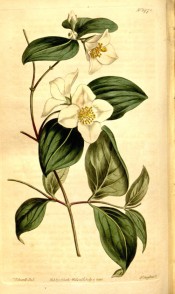Philadelphus inodorus L.
Fully hardy, arching shrub with peeling bark on older branches, entire, elliptic leaves, to 9cm long, finely toothed, and cymes of white flowers in summer. To 3m. [RHSD, Hortus].
Horticultural & Botanical History
‘The Philadelphus inodorus is a very desirable shrub, the flowers being considerably larger, and of a purer white than those of the coronarius; and to most people are not the less acdeptable for being without a scent, that of the mock orange being far to powerful to be generally agreeable even without doors. Being a native of Carolina, though hardy enough to bear our winters when not unusually severe, it must be liable to be destroyed occasionally. To this cause we suppose is to be attributed the present scarcity of a plant introduced into the country before the year 1738.’ [BM t.1478/1812].
The Botanical Register figures Philadephus grandiflorus Willd., now recognised as P. inodorus var. grandiflorus (Willd.) A.Gray, synonym Philadelphus inodorus Hort. ex Poir. [BR f.570/1821].
History at Camden Park
Listed in the 1845, 1850 and 1857 catalogues [T.747/1845].
Notes
Philadelphus inodorus Stuv. ex Schrad. (1838) = Philadelphus hirsutus Nutt. another North American species.
Published Feb 14, 2010 - 12:28 PM | Last updated Feb 14, 2010 - 12:40 PM
| Family | Hydrangeaceae |
|---|---|
| Category | |
| Region of origin | Eastern USA |
| Synonyms | |
| Common Name | Mock orange |
| Name in the Camden Park Record |
Philadelphus inodorus |
| Confidence level | high |
